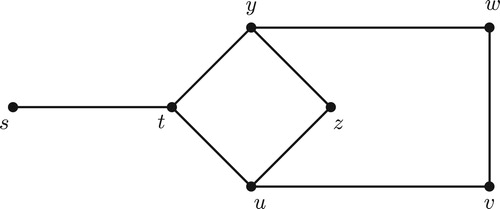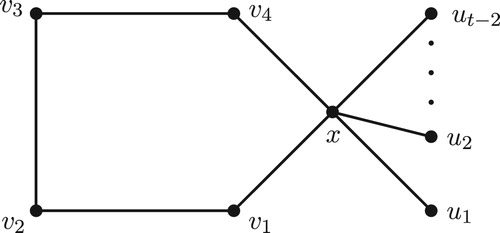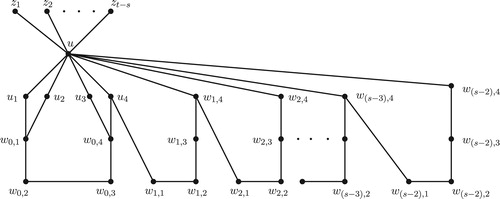Abstract
For any two vertices and
in a connected graph
, an
–
path is a monophonic path if it contains no chord, and a longest
–
monophonic path is called an
–
detour monophonic path. For any vertex
in
, a set
is an
-detour monophonic set of
if each vertex
lies on an
–
detour monophonic path for some element
in
. The minimum cardinality of an
-detour monophonic set of
is the
-detour monophonic number of
, denoted by
. A subset
of a minimum
-detour monophonic set
of
is an
-forcing subset for
if
is the unique minimum
-detour monophonic set containing
. An
-forcing subset for
of minimum cardinality is a minimum
-forcing subset of
. The forcing
-detour monophonic number of
, denoted by
, is the cardinality of a minimum
-forcing subset for
. The forcing
-detour number of
is
, where the minimum is taken over all minimum
-detour monophonic sets
in
. We determine bounds for it and find the same for some special classes of graphs. Also we show that for every pair
of integers with
, there exists a connected graph
such that
and
for some vertex
in
.
1 Introduction
By a graph we mean a non-trivial finite undirected connected graph without loops or multiple edges. The order and size of
are denoted by
and
respectively. For basic graph theoretic terminology we refer to Harary [Citation1]. For vertices
and
in a connected graph
, the distance
is the length of a shortest
path in
. An
path of length
is called an
geodesic. The neighborhood of a vertex
is the set
consisting of all vertices
which are adjacent with
. The closed neighborhood of a vertex
is the set
. A vertex
is an extreme vertex of
if the subgraph induced by its neighbors is complete.
The closed interval consists of all vertices lying on some
geodesic of
, while for
,
. A set
of vertices is a geodetic set if
, and the minimum cardinality of a geodetic set is the geodetic number
. A geodetic set of cardinality
is called a
-set of
. The geodetic number of a graph was introduced in [Citation2] and further studied in [Citation3–Citation[4]Citation5].
The concept of vertex geodomination in graphs was introduced in [Citation6] and further studied in [Citation7]. Let be a vertex of a connected graph
. A set
of vertices of
is an
-geodominating set of
if each vertex
of
lies on an
geodesic in
for some element
in
. The minimum cardinality of an
-geodominating set of
is defined as the
-geodomination number of
and is denoted by
.
A chord of a path is an edge joining any two non-adjacent vertices of
. A path
is called a monophonic path if it is a chordless path. A longest
monophonic path
is called an
detour monophonic path. The monophonic distance
from
to
is defined as the length of a longest
monophonic path (or
detour monophonic path) in
. The monophonic eccentricity
of a vertex
in
is
. The monophonic radius,
of
is
and the monophonic diameter,
of
is
. The monophonic distance was introduced in [Citation8] and further studied in [Citation9].
The concept of vertex detour monophonic number was introduced in [Citation10]. Let be a vertex of a connected graph
. A set
of vertices of
is an
-detour monophonic set of
if each vertex
of
lies on an
detour monophonic path in
for some element
in
. The minimum cardinality of an
-detour monophonic set of
is defined as the
-detour monophonic number of
and is denoted by
. An
-detour monophonic set of cardinality
is called a
-set of
.
2 Forcing vertex detour monophonic number
Let be any vertex of a connected graph
. Although
contains a minimum
-detour monophonic set there are connected graphs which may contain more than one minimum
-detour monophonic set. For example the graph
given in contains more than one minimum
-detour monophonic set. For each minimum
-detour monophonic set
in a connected graph
there is always some subset
of
that uniquely determines
as the minimum
-detour monophonic set containing
. Such sets are called “vertex forcing subsets” and we discuss these sets in this section. Also, forcing concepts have been studied for such diverse parameters in graphs as the graph reconstruction number [Citation11], the domination number [Citation12], and the geodetic number [Citation13].
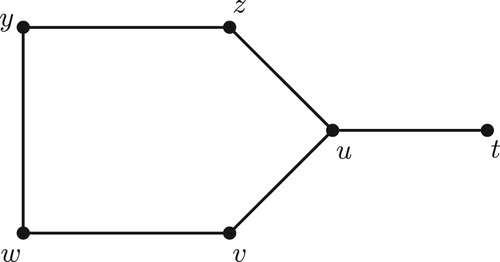
Definition 2.1
Let be a vertex of a connected graph
and let
be a minimum
-detour monophonic set of
. A subset
of
is called an
-forcing subset for
if
is the unique minimum
-detour monophonic set containing
. An
-forcing subset for
of minimum cardinality is a minimum
-forcing subset of
. The forcing
-detour monophonic number of
, denoted by
, is the cardinality of a minimum
-forcing subset of
. The forcing
-detour monophonic number of
is
, where the minimum is taken over all minimum
-detour monophonic sets
in
.
Example 2.2
For the graph given in , the minimum vertex detour monophonic sets, the vertex detour monophonic numbers, the minimum forcing vertex detour monophonic sets and the forcing vertex detour monophonic numbers are given in .
Table 2.1 The forcing vertex detour monophonic numbers of the graph  given in .
given in .
The next theorem immediately follows from the definition of -detour monophonic number and forcing
-detour monophonic number of a graph
.
Theorem 2.3
For any vertex in a connected graph
,
.
The bounds in Theorem 2.3 are sharp. For the graph given in ,
. Also, for the graph
given in ,
and
are the minimum
-detour monophonic sets of
and so
. It is easily verified that no minimum
-detour monophonic set is the unique minimum
-detour monophonic set containing any of its proper subsets. It follows that
and hence
. The inequalities in Theorem 2.3 can be strict. For the graph
given in ,
and
. Thus
.
In the following theorem we characterize graphs for which the bounds in Theorem 2.3 are attained and also graphs for which
.
Theorem 2.4
Let be a vertex of a connected graph
. Then
(i) if and only if
has a unique minimum
-detour monophonic set.
(ii) if and only if
has at least two minimum
-detour monophonic sets and one of which is a unique minimum
-detour monophonic set containing one of its elements.
(iii) if and only if no minimum
-detour monophonic set of
is the unique minimum
-detour monophonic set containing any of its proper subsets.
Definition 2.5
A vertex of a connected graph
is said to be an
-detour monophonic vertex of
if
belongs to every minimum
-detour monophonic set of
.
For the graph in ,
and
are the minimum
-detour monophonic sets and so
and
are the
-detour monophonic vertices of
. In particular, every extreme vertex of
other than
is an
-detour monophonic vertex of
.
The following theorem and corollary follows immediately from the definitions of an -detour monophonic vertex and forcing
-detour monophonic subset of
.
Theorem 2.6
Let be a vertex of a connected graph
and let
be the set of relative complements of the minimum
-forcing subsets in their respective minimum
-detour monophonic sets in
. Then
is the set of
-detour monophonic vertices of
.
Corollary 2.7
Let be a connected graph and
a minimum
-detour monophonic set of
. Then no
-detour monophonic vertex of
belongs to any minimum
-forcing subset of
.
Theorem 2.8
Let be a vertex of a connected graph
and let
be the set of all
-detour monophonic vertices of
. Then
.
Proof
Let be any minimum
-detour monophonic set of
. Then
,
and
is the unique minimum
-detour monophonic set containing
and so
. □
Corollary 2.9
If is a complete graph or a tree or a complete bipartite graph, then
for any vertex
in
.
Proof
It is easily seen that has unique minimum
-detour monophonic set for any vertex
in
. Hence the result follows from Theorem 2.4(i). □
Theorem 2.10
For any vertex in the cycle
of order
,
or
according as
is even or odd.
Proof
Let be a cycle of order
. Let
be any vertex in
, say
. If
is even, then
is the unique minimum
-detour monophonic set of
and so by Theorem 2.4(i),
. If
is odd, then
and
are the minimum
-detour monophonic sets of
. Hence it follows from Theorem 2.4(i) that
. Clearly,
is a minimum
-forcing subset of
and so
. □
Theorem 2.11
Let be the wheel.
(i) If is odd, then
for any vertex
in
.
(ii) If is even, then
or
according as
is
or
is in
.
Proof
Let be a cycle of order
and
the vertex of
. If
is odd, then
has the unique minimum
-detour monophonic set of
for any vertex
in
and so by Theorem 2.4(i),
. Now, assume that
is even. If
, then
is the unique minimum
-detour monophonic set of
and so by Theorem 2.4(i),
. If
, say
, then
and
are the minimum
-detour monophonic sets of
. Hence it follows from Theorem 2.4(i) that
. Clearly,
is a minimum
-forcing subset of
and so
. □
We proved in Theorem 2.3 that for any vertex
in
. Already we have seen that if
is a complete graph
, then
and
for any vertex
in
. Also for the graph
given in ,
and
for the vertex
. The following theorem gives a realization for these parameters when
.
Theorem 2.12
For every pair of integers with
, there exists a connected graph
such that
and
for some vertex
in
.
Proof
For each integer with
, let
be a path of order 4 and let
be a star with
. Let
be the graph obtained from
and
by (i) join
with
and
in
(ii) join
with
and
in
(iii) join each
with
in
(iv) join each
with
and (v) join
with
in
. Now, let
be the graph obtained from
by adding
new vertices
and joining each
with
. The graph
is shown in .
Let and let
be the set of all extreme vertices of
. Let
,
and
. First we claim that
. Now, we observe that a set
of vertices of
is a
-set if and only if
contains exactly one vertex from each set
and
contains
so that
. Since
is an
-detour monophonic set of
with
, it follows that
.
Next, we prove that . Let
be a
-set of
and let
be any minimum
-forcing subset of
. Then, by Theorem 2.8, we get
.
If , then there exists a vertex
such that
. It is clear that
for some
, say
. Let
. Then
and
is also a minimum
-detour monophonic set of
such that it contains
, which is a contradiction to
an
-forcing subset of
. Thus
and so
. □
3 Upper forcing vertex detour monophonic number
The cardinality of vertex forcing subsets depend on the corresponding minimum vertex detour monophonic set of . In this observation, we discuss these sets with minimum cardinality in the previous section. Now, we deal about vertex forcing subsets with maximum cardinality in this section.
Definition 3.1
Let be any vertex of a connected graph
. The upper forcing
-detour monophonic number,
, of
is the maximum forcing
-detour monophonic number among all minimum
-detour monophonic sets of
.
Example 3.2
For the graph given in , the minimum vertex detour monophonic sets, the vertex detour monophonic numbers, the forcing vertex detour monophonic sets, the minimum forcing vertex detour monophonic numbers and upper forcing vertex detour monophonic numbers are given in .
Table 3.1 The upper forcing vertex detour monophonic numbers of the graph  given in .
given in .
From , the forcing vertex detour monophonic number and the upper forcing vertex detour monophonic number of a graph are different.
Next we present two theorems whose routine proof is omitted.
Theorem 3.3
For any vertex in a connected graph
,
.
Theorem 3.4
Let be a vertex of a connected graph
. Then
(i) if and only if
has a unique minimum
-detour monophonic set.
(ii) if and only if
has at least two minimum
-detour monophonic sets and every
-set is the unique
-set containing one of its elements.
(iii) if and only if no minimum
-detour monophonic set of
is the unique minimum
-detour monophonic set containing any of its proper subsets.
Theorem 3.5
For any vertex in the cycle
of order
,
or
according as
is even or odd.
Proof
Let be a cycle of order
. Let
be any vertex in
, say
. If
is even, then
is the unique minimum
-detour monophonic set of
and so by Theorem 3.4(i),
. If
is odd, then
and
are the minimum
-detour monophonic sets of
. Hence it follows from Theorem 3.4(i) that
. Also,
is one of the minimum
-detour monophonic set of
. It is easily verified that any proper subset of
is contained in some other minimum
-detour monophonic set of
and so
. □
Theorem 3.6
Let be the wheel.
(i) If is odd, then
for any vertex
in
.
(ii) If is even, then
or
according as
is
or
is in
.
Proof
Let be a cycle of order
and let
be the vertex of
. If
is odd, then
has the unique
-set for any vertex
in
and so by Theorem 3.4(i),
. Now, assume that
is even. If
, then
-set is unique and so
. If
, say
, then
and
are the minimum
-detour monophonic sets of
. Hence it follows that
is the unique forcing
-detour monophonic set of the minimum
-detour monophonic set
so that
. Since
is the
-detour monophonic vertex of
, by Corollary 2.7, we have
. □
Note that we have for every connected graph
. The following theorem gives a realization result for the parameters
and
.
Theorem 3.7
For any three positive integers and
with
and
, there exists a connected graph
with
and
for some vertex
in
.
Proof
We prove this theorem by considering 3 cases.
Case 1. . For each integer
with
, let
be a path of order 4, for each integer
with
, let
be another path of order 4 and let
be a star with
. Let
be the graph obtained from
and
by (i) join
with
and
in
(ii) join
with
and
in
(iii) join each
with
in
(iv) join each
with
(v) join
with
in
and (vi) join each
with
in
. Now, let
be the graph obtained from
by adding
new vertices
and joining each
with
. The graph
is shown in .
Let and let
be the set of all extreme vertices of
. Let
and
. Also, for
, let
and
. Now, we observe that a set
of vertices of
is a
-set if
contains exactly one vertex from each set
,
contains
and
contains for each
exactly one set from
. Hence
. Since
is an
-detour monophonic set of
with
, it follows that
.
Next, we prove that and
. Let
be any minimum
-forcing subset of
. Then by Theorem 2.8,
. Since any subset of a minimum
-detour monophonic set with cardinality less than
contained in more than one minimum
-detour monophonic set of
, we have
. It is easily seen that
is a minimum
-forcing subset of a minimum
-detour monophonic set
and
is a minimum
-forcing subset of a minimum
-detour monophonic set
of
. It follows that
and
.
Case 2. . For each integer
with
, let
be a path of order 4. Let
be the graph obtained from
by (i) join
with
and
(ii) join
with
and
(iii) join
with
and (iv) join
with
. For each integer
with
, let
be a path of order 4. Let
be the graph obtained from
and
by joining each
and
with
in
. The graph
is obtained from
by adding
new vertices
and joining each
with
in
. The graph
is shown in .
Let and let
be the set of all extreme vertices of
. Also, for
, let
and
. Now, we observe that a set
of vertices of
is a
-set if
contains exactly one vertex from
and
contains
, and for each
exactly one set from
. Hence
. Since
is an
-detour monophonic set of
with
, it follows that
.
Next, we prove that and
. Let
be any minimum
-forcing subset of
. Then by Theorem 2.8,
. Since any subset of a minimum
-detour monophonic set with cardinality less than
contained in more than one minimum
-detour monophonic set of
, we have
. It is easily seen that
is a minimum
-forcing subset of a minimum
-detour monophonic set
and
is a minimum
-forcing subset of a minimum
-detour monophonic set
of
. It follows that
and
.
Case 3. . For each
with
, let
be a path of order 4 and let
be a star with
. Let
be the graph obtained from
and
by (i) join
with
in
and (ii) join
with
in
. The graph
is shown in .
Let and let
be the set of all extreme vertices of
. For
, let
and
. Now, we observe that a set
of vertices of
is a
-set if
contains
and
contains for each
exactly one set from
. Hence
. Since
is an
-detour monophonic set of
with
, it follows that
.
Next, we prove that and
. Let
be any minimum
-forcing subset of
. Then by Theorem 2.8,
. Since any subset of a minimum
-detour monophonic set with cardinality less than
contained in more than one minimum
-detour monophonic set of
, we have
. It is easily seen that
is a minimum
-forcing subset of minimum
-detour monophonic set
and
is a minimum
-forcing subset of a minimum
-detour monophonic set
of
. It follows that
and
. □
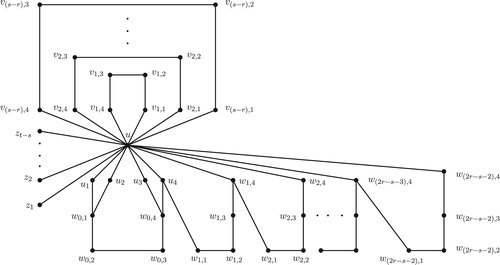
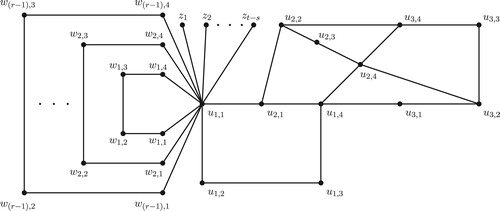
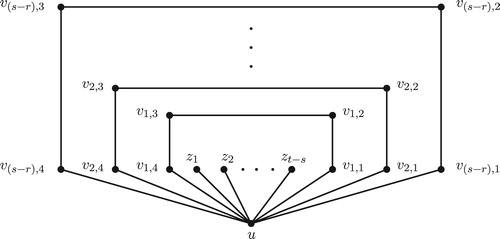
Problem 3.8
For any three positive integers and
with
and
, does there exist a connected graph
with
and
for some vertex
in
?
Notes
Research supported by DST Project No. SR/S4/MS: 570/09.
Peer review under responsibility of Kalasalingam University.
References
- F.HararyGraph Theory1969Addison-Wesley
- F.HararyE.LoukakisC.TsourosThe geodetic number of a graphMath. Comput. Model.171119938995
- F.BuckleyF.HararyDistance in Graphs1990Addison-WesleyRedwood City, CA
- F.BuckleyF.HararyL.U.QuintasExtremal results on the geodetic number of a graphScientia A219881726
- G.ChartrandF.HararyP.ZhangOn the geodetic number of a graphNetworks391200216
- A.P.SanthakumaranP.TitusVertex geodomination in graphsBull. Kerala Math. Assoc.2220054557
- A.P.SanthakumaranP.TitusOn the vertex geodomination number of a graphArs Combin.1012011137151
- A.P.SanthakumaranP.TitusMonophonic distance in graphsDiscrete Math. Algorithms Appl.322011159169
- A.P.SanthakumaranP.TitusA note on monophonic distance in graphsDiscrete Math. Algorithms Appl.422012
- P. Titus, P. Balakrishnan, The vertex detour monophonic number of a graph, communicated.
- F.HararyM.PlantholtThe graph reconstruction numberJ. Graph Theory91985451454
- G.ChartrandH.GavlasF.HararyR.C.VandellThe forcing domination number of a graphJ. Combin. Math. Combin. Comput.251997161174
- G.ChartrandP.ZhangThe forcing geodetic number of a graphDiscuss. Math. Graph Theory1919994558


